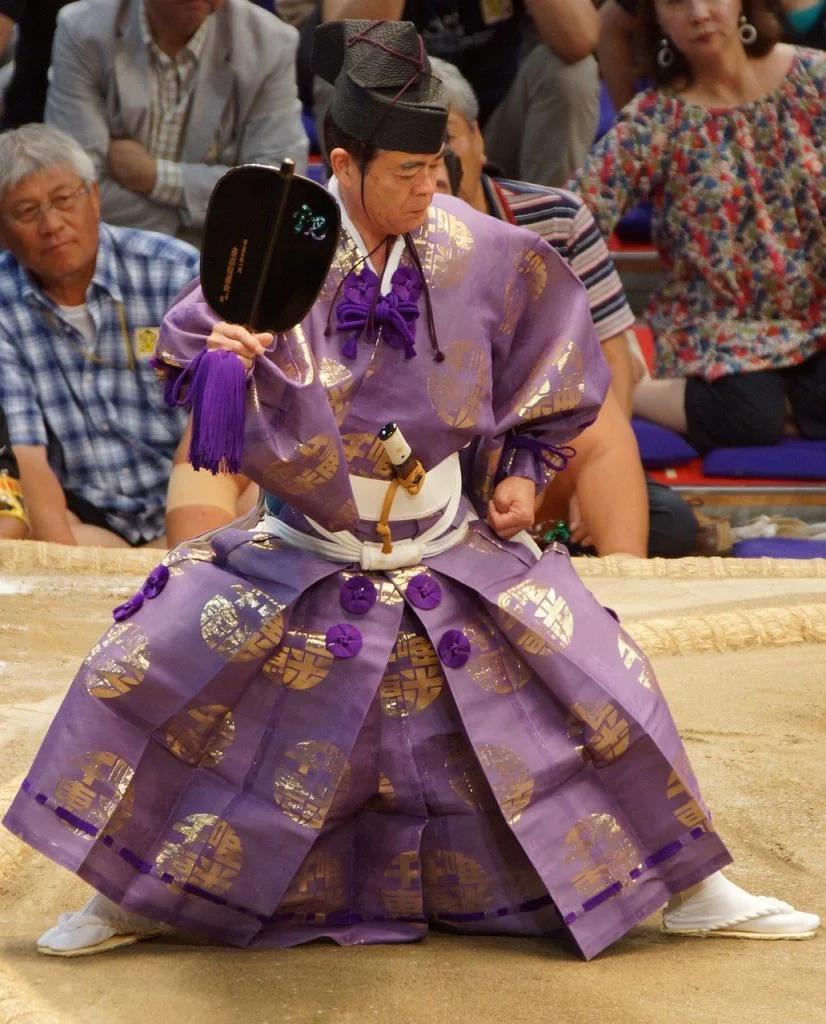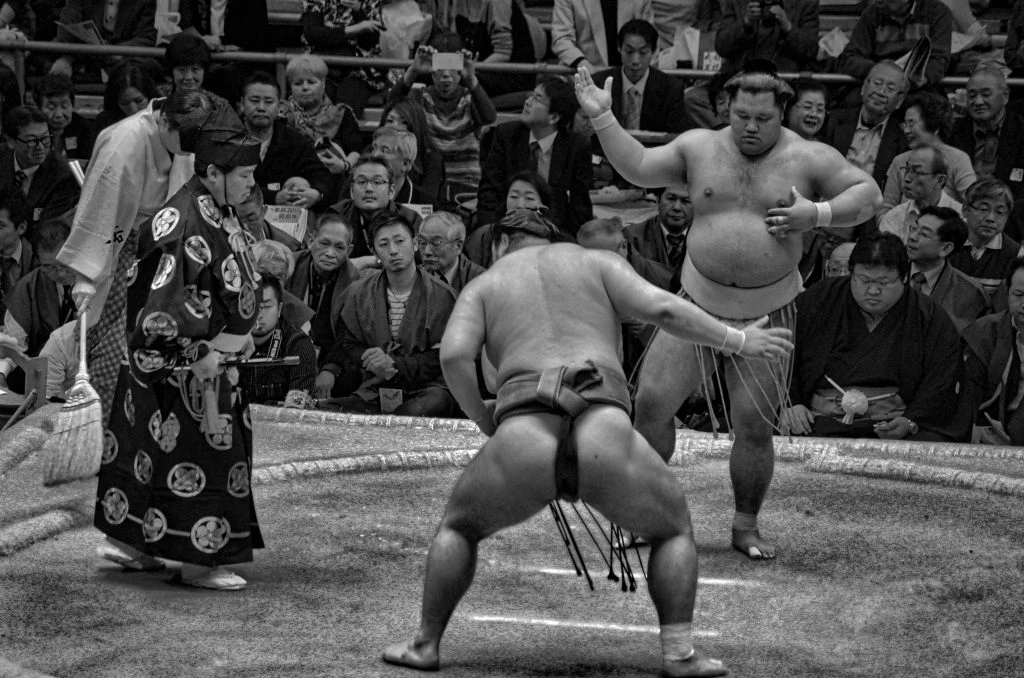Welcome to the chunky, thunky world of sumo wrestling! If you’re wondering if there’s more to sumo than epic belly showdowns, you bet your sushi there is.
Having spent more time researching sumo than I care to admit (and dreaming of being the Yokozuna of trivia nights), I’ve got 50 juicy facts to share. Before I start, I want to ask you something. Have you ever tried sumo wrestling your cat?
Sumo is life. It’s not just a sport.
Taiho Koki
Sumo Wrestling Facts
It’s time to serve you a sumo-sized scoop of facts. Wrestle your way through, but remember: I have created a quiz at the end of this post to check if you are a real sumo fan or an imposter.
- Roots: Sumo wrestling has been a part of Japanese history for over 1,500 years, originating as a sacred sport.
- Sumo possesses deep ties with Shinto religious practices and customs.
- Traditionally, it served as entertainment for deities and a way to foresee the success of the annual harvest.
- In sumo, the goal is to either push the adversary outside of the dohyō (ring) or make any part of their body except the feet touch the floor.
- Wrestlers: In sumo terminology, the athletes are referred to as rikishi.
- Every year, six significant sumo championships, or honbasho, take place.
- Apex: Yokozuna is considered the pinnacle rank in sumo wrestling.
- Attaining the rank of Yokozuna is challenging, necessitating sustained excellence, dignity, and a sense of grandeur.
- Rikishi adorn themselves with a special belt known as a mawashi.
- Rikishi reside and practice in sumo stables, or heya, supervised by a stable master.
- Leg Movement: Shiko refers to the traditional act of lifting and stomping the legs to ward off malevolent spirits during sumo.
- A ring-entering ceremony, or dohyō-iri, is performed by rikishi before matches.
- Rikishi wear distinctive hairstyles, with the chonmage being particularly emblematic.

- Diet: Chanko-nabe, a robust stew, is a dietary mainstay for sumo wrestlers.
- Sumo bouts are generally brief, ranging from a couple of seconds to several minutes.
- Trophy: Yusho symbolizes the championship award given to the sumo tournament victor.
- Purification is part of the process, with Rikishi executing a salt-throwing ritual ahead of bouts.
- Sumo lacks weight categories, enabling wrestlers of various sizes to compete against each other.
- Ceremonial Garb: Kesho-mawashi is a decorative apron worn during ceremonial appearances.
- Sumo wrestlers are expected to uphold conventional Japanese demeanor and a way of life beyond the ring.
- High Rank: Ozeki signifies the rank just beneath Yokozuna in sumo.
- A gyoji, donned in traditional attire, serves as the match referee.
- Before turning professional, sumo wrestlers begin as mae-zumo.
- Promotions in rank for rikishi are determined by their tournament performances, not solely by victories.
- Defeating a Yokozuna earns a maegashira-ranked wrestler a kinboshi.
- Henka, a maneuver involving evasion at a bout’s onset, often sparks debates.
- An end-of-day ceremony, the Yumitori-shiki, involves a significant bow dance ritual.
- Risk: Kadoban refers to an Ozeki at risk of demotion due to subpar performance.

- Rikishi, known for their substantial physique, adhere to an intense regimen of training and nutrition.
- Within their stables, rikishi must comply with a stringent hierarchical system, with senior wrestlers enjoying certain benefits.
- Modern influences have impacted sumo, but its core traditional attributes have remained intact.
- Tournament days traditionally commence with lower-ranked wrestlers and conclude with premier bouts.
- About 800 rikishi are professionally active in Japan.
- Contemporary designs and logos occasionally adorn the ceremonial kesho-mawashi, often due to sponsorship.
- Infraction: Hansoku represents a rare occurrence of disqualification in sumo.
- Mono-ii denotes a consultation among judges in cases of uncertain match outcomes.
- The initial confrontation in a sumo match is termed the tachiai.
- Controversy has surrounded sumo due to its exclusion of women from competition and certain ceremonial areas.
- Restart: Matta signifies a bout’s false start, leading to its recommencement.
- Traditional codes prevent Rikishi from driving, citing safety and the upkeep of customs.

- The dohyō is crafted from a unique clay, possessing a thickness of around 34 centimeters.
- Rankings: Komusubi and Sekiwake are classifications that succeed the Ozeki rank.
- Historically, only voluntary retirement could lead to a Yokozuna’s demotion, not performance metrics.
- Notable Figure: Haramafuji, originating from Mongolia, was a distinguished Yokozuna for numerous years.
- The ring, or dohyō, is marked by a symbolic wooden structure named tsuriyane, reminiscent of a Shinto shrine.
- Rikishi typically live in communal settings within their stables, partaking in chores and responsibilities based on rank.
- Sumo has faced challenges with allegations of match-fixing, but such cases are rare and heavily scrutinized.
- Tsuna is the heavy rope worn by a Yokozuna, signifying his rank, and adorned with paper strips.
- Retired rikishi often become oyakata, or sumo elders, guiding younger wrestlers in their journey.
- Sumo was once considered for the Olympics, especially when Tokyo hosted the games, but it remains a uniquely Japanese professional sport.
Sumo Wrestling Myths

There are some common myths in the history of sumo wrestling. After doing some research, I found the truth about some of them. Let’s take a look at them.
- Sumo Wrestlers Are Just Fat.
Hold up! Those hefty figures are chock-full of muscle. Yep, beneath that bulk, there’s a powerhouse of strength and agility, all honed through grueling daily workouts. They’re not just big; they’re beastly strong. - They Eat Whatever They Want.
Surprisingly nope! Those big guys are slurping down chanko-nabe, a hearty, healthy stew. Junk food? Rarely. They’ve got a meal-game plan that makes sure they’re beefing up the right way. - Sumo Wrestling Is Only Popular in Japan.
While Japan is the sumo epicenter, this sport’s causing ripples worldwide. You’ll find sumo enthusiasts from Mongolia to Georgia making waves in the big league, and tournaments are popping up everywhere. - It’s Just Two Guys Trying to Push Each Other.
Well, there’s more to the dance! It’s like chess, but with body slams. Every move, every stance, it’s all calculated. It’s not just about brute force; it’s a mind game with a side of muscle. - Sumo Wrestlers Live Short Lives.
Sure, the sumo life is demanding, but saying they all face early curtain calls? That’s stretching it. Plenty of retired wrestlers kick back, trim down, and enjoy the long, healthy ride post-ring action.
No products found.
Sumo Wrestling Quotes

Finding famous quotes was quite hard, mostly because sumo is deeply intertwined with Japanese culture and people don’t document its narratives globally, but I found this list. I hope you enjoy it.
The spirit of Japan, its ancient traditions, and its age-old values, all are to be found in sumo.
Wajima Hiroshi
In sumo, the popular saying is, ‘If you’re not moving forward, you’re moving backward.
Kotoshogiku Kazuhiro
When I eat, I eat. When I practice, I practice. There is no magic.
Takanohana
Sumo is life; it’s not just a sport.
Taiho Koki
The ring is sacred. It’s where men’s dreams and hopes come to fruition or get dashed.
Chiyonofuji Mitsugu
Sumo Wrestling FAQ

We are one segment away from the final showdown (I mean the quiz), so let’s see some of the most asked questions about sumo wrestling.
- Why are sumo wrestlers fat?
In sumo, size matters! The bigger you are, the harder you are to budge. It’s not just about piling on weight, though. They’re a mix of brawn and belly, making them both powerful and stable in the ring. - What do sumo wrestlers eat?
Ever heard of chanko-nabe? It’s like a power-packed hotpot! Full of chicken, fish, veggies, and tofu, it’s their go-to meal. Imagine a big pot of this stew, a mountain of rice, and maybe some beer – that’s a sumo feast! - When did sumo wrestling start?
Going back over 1,500 years, sumo started as a way to entertain gods and pray for good harvests in Japan. From sacred ritual to full-blown sport, it’s been quite the journey! - Who invented sumo wrestling?
Well, no one person “invented” it. But legend has it that two gods, Takemikazuchi and Takeminakata, settled their differences in a sumo-style showdown. Mythical? Yes. But it gives you an idea of how deep-rooted sumo is in Japanese culture. - Is sumo wrestling a sport?
It’s a fiercely competitive sport with grand tournaments. But with all its rituals and traditions, it’s also like stepping into a living piece of Japanese history.
No products found.
Sumo Wrestling Quiz

Are you ready to rumble with my sumo quiz? But remember this: zero correct answers means trying to push a sumo wrestler out of your house.
Conclusion
After diving deep into the hefty world of sumo wrestling, one can’t help but ponder: Do sumo wrestlers have a secret handshake? Or maybe just a challenging time finding jeans that fit?
All jokes aside, this ancient sport holds a vast sea of history, discipline, and tight mawashi (that’s their belt, in case you missed it). So, the next time you consider taking up a new hobby, why not sumo? How do you feel about trading your morning jog for a sumo squat?


